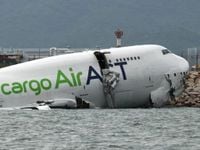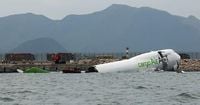In the early hours of October 20, 2025, Hong Kong International Airport—one of Asia’s busiest aviation hubs—witnessed its deadliest incident in over a quarter-century. An Emirates Boeing 747 cargo plane, operated by Turkish freight carrier ACT Airlines, skidded off the north runway during landing and plunged into the sea, colliding with a security patrol vehicle and killing two airport security staff. The shocking event has prompted an intense investigation and left the city’s aviation community grappling with grief and unanswered questions.
The accident occurred at approximately 3:50 a.m. local time, as the cargo flight EK9788, inbound from Dubai’s Al Maktoum International Airport, attempted to land on runway 07L. According to the Associated Press, the aircraft had taxied about halfway down the runway before suddenly veering left, crashing through the perimeter fencing, and careening into the waters just off the airport’s sea wall. The Boeing 747, a 32-year-old aircraft that had previously served as a passenger jet before being converted to a freighter, was partially submerged with its nose and tail sections separated, as shown in dramatic photos broadcast by local media and published by Reuters.
Tragically, two airport security personnel—both longtime employees, with seven and twelve years of service respectively—were inside a petrol patrol car operating in its usual area outside the runway fence. As detailed by ABC Audio, the plane struck the ground vehicle, pushing it into the sea. Steven Yiu, executive director of airport operations at Airport Authority Hong Kong, was quick to clarify during a press conference: “The patrol car absolutely did not rush onto the runway. It was the plane that went off the runway and crashed into the patrol car outside the fence.”
Rescue operations began immediately. The Airport Emergency Centre was activated, and emergency crews raced to the scene. Fire services official Yiu Men-yeung described the harrowing rescue: divers located the submerged vehicle more than 22 feet under water and about 16 feet from the embankment. The two security staff were found trapped inside and were not breathing when recovered. One was declared dead at the scene, while the other died after being transported to a hospital, according to Hong Kong police and TVNZ.
Meanwhile, the plane’s four crew members—operating under a wet lease arrangement where ACT Airlines provided the aircraft, crew, maintenance, and insurance for Emirates—were rescued from the partially submerged fuselage. They were found waiting at an open door and were taken to hospital, but suffered no apparent injuries. ACT Airlines later confirmed: “All four crew members on board have been confirmed to be in good health. Unfortunately, we have been informed that the aircraft collided with a ground services vehicle, resulting in loss of two lives.” Emirates also stated there was no cargo on board at the time of the crash, as reported by AP. (Some outlets initially reported there was cargo present, but Emirates’ statement clarified this point.)
Flight tracking service FlightRadar24, cited by The Express Tribune, revealed that the aircraft was traveling at about 49 knots when it hit the water. The weather and runway conditions were reported as safe for operation, and the plane never signaled any technical issue before the abrupt deviation. An air traffic control recording reviewed by Reuters showed the pilot confirming plans to land on the north runway, with no distress call or request for assistance made before the incident. Man Ka-chai, chief accident and safety investigator for Hong Kong’s Air Accident Investigation Authority, confirmed, “We didn’t receive any message requesting help from the pilot.”
As the investigation unfolds, authorities are focusing on multiple factors, including the aircraft’s systems, operational procedures, and maintenance records. The cockpit voice recorder and flight data recorder are being sought to piece together the final moments before the crash. The Air Accident Investigation Authority has classified the event as an accident and is collaborating with ACT Airlines, Emirates, and other relevant parties. Weather, runway conditions, the aircraft itself, and the actions of the aircrew are all under scrutiny.
Steven Yiu of the Airport Authority emphasized the support being provided to the families of the deceased, recognizing the profound loss suffered by the airport community. "The airport authority would provide all necessary assistance and support to the family," he said, highlighting the dedication and service of the two staff members lost in the tragedy.
Despite the severity of the incident, the operational impact on Hong Kong International Airport was contained. The north runway was closed for safety inspections and investigation, but the airport’s south and central runways continued to operate normally. Flights were not affected, and the airport authority assured the public that safety remained the top priority.
The accident marks the deadliest at Hong Kong International Airport since a China Airlines flight crashed on landing in 1999, resulting in three fatalities among 315 people on board, according to the Aviation Safety Network database. The current tragedy has reignited discussions about safety at airports built on reclaimed land, such as Hong Kong’s, where runways lie just a few hundred meters from the sea, increasing the risk of such rare but catastrophic events.
Emirates, well known for its vast passenger operations and growing cargo business, has been using wet-leased Boeing 747s to meet surging demand for freight capacity. The airline, owned by Dubai’s sovereign wealth fund, operates a fleet of around 260 aircraft, primarily Boeing 777s and Airbus A380s. ACT Airlines, the Turkish operator of the crashed jet, is recognized for providing extra cargo lift to major airlines worldwide, including Emirates.
As the investigation continues, the aviation world watches closely for answers. The cause of the sudden veer and subsequent collision remains a mystery, with all eyes on the technical analysis of flight recorders and the review of operational procedures. For now, the focus remains on supporting the families of those lost and ensuring that such a tragedy does not repeat itself at one of the world’s busiest gateways.
In the aftermath of this harrowing event, the resilience of Hong Kong’s airport community is evident, but so too is the need for answers—and for the lessons that will inevitably follow.

